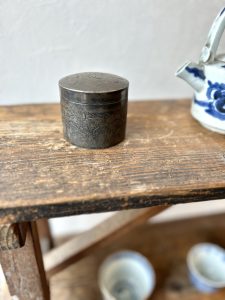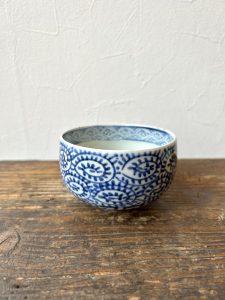ゆっくりお茶の時間を楽しむ幸福(愛知県名古屋市千種区姫池通 骨董買取 古美術風光舎)
2024.04.03
皆さまこんにちは。スッタフHでございます。
ここ数日、寝不足ではないのですが、日中眠気に襲われることがあります。
「春眠暁を覚えず…」という有名な漢詩がありますが、意味は「春の眠りは心地よいため、朝になったことに気づかず眠り込み、なかなか目が覚めない」だそうです。しかし実際には春は昼夜の寒暖差や日照時間が長くなることによって体内時計のずれが生じ、自律神経の乱れが引き起こされ睡眠の質が落ちる人が多いそうです。
私は日頃コーヒーをよく飲みますが、春の眠気を覚まそうとしているのか、いつもより飲む回数が増えた気がいたします。ただ不思議なことに実家に帰るとなぜか一日中、緑茶を飲んでおります。恐らく急須と茶筒が常に見える場所に置いてあるからだと思います。
少し前の日本の食卓には、当たり前のように急須と茶筒のセットが置かれていたように思います。特に茶筒はシンプルな形状でどこに置いても邪魔にならず風景に馴染んでいました。

日本人がお茶をたしなむようになったのは、記録によると奈良時代からと言われています。当時は身分の高い人々の間でのみ広がっていましたが、戦国時代から江戸時代にかけて茶葉の生産量が増え庶民の間でも飲まれるようになりました。湯でお茶の葉のエキスを抽出し煎じて飲むという手軽さから庶民の間に一気に広まったとされています。
また江戸中期には「抹茶道」に対して「煎茶道」と呼ばれる茶道が広まりました。
「抹茶道」は中国宋の時代の抹茶法が日本に伝わり、千利休が桃山時代に完成させたものです。抹茶道は禅の思想と密接に結びつき、時の権力者である織田信長や豊臣秀吉が重んじたことで、徐々に大名の権力を表す手段となっていきました。
一方「煎茶道」は中国明の時代の喫茶法である茶葉を使った飲み方を元とし、老荘思想における無為自然の姿を理想とする作法と言われています。15世紀に、九州地方に漂着した明の人々によって釜炒り茶が伝えられ、17世紀に中国製の急須に釜炒り茶を煎じて飲む喫茶法を教えたと伝えられています。
18世紀に入ると、僧侶であった高遊外(こうゆうがい)が長崎で習得した煎茶の知識を活かし、京で煎茶を売り歩くようになります。そのため売茶翁(ばいさいおう)と呼ばれるようになったとか。それまで上流階級に限られてきたお茶の世界を庶民にも広めていきました。
また中国の文人達の暮らしに憧れ、思いをはせる京都の文人墨客にも受け入れられていき、売茶翁の茶風を慕う文人の中には、南画家の池大雅や「雨月物語」の作者である上田秋成など多彩な知識人がおり、文人煎茶のスタイルが形成されていったそうです。
幕末にかけて一層盛んになっていき、茶道に見られるような「体系化」や「道化」が進み、煎茶道の家元が生まれ、流派も増えていきます。
煎茶道にも作法や型はありますが、あくまでも共に過ごす相手にお茶を美味しく飲んで楽しんでもらうことを第一とし、なによりその時間を一緒に楽しむことに重きを置いているといいます。
まさにコーヒーであろうが紅茶であろうが、「お茶していく?」と誘う私は、日本の煎茶道が染みついているようです。
そして実家ではなぜか緑茶ばかり飲みたくなってしまうのは、家族とゆっくり穏やかな時間を共有するためなのかもしれません。

それでは、また次の機会に。
Hello everyone. My name is Staff H.
For the past few days, I have been feeling sleepy during the daytime, although I have not been sleeping well.
There is a famous Chinese poem that says, “In spring, sleep is so comfortable that you fall asleep without realizing that it is morning and do not wake up easily. In reality, however, the difference in temperature between day and night and the lengthening of daylight hours in spring cause a shift in the body’s internal clock, leading to a disturbance in the autonomic nervous system, and many people suffer from poor sleep quality.
I often drink coffee, but I feel that I drink more than usual, perhaps to wake up from the drowsiness of spring. But strangely enough, when I go home to my parents’ house, for some reason I drink green tea all day long. Perhaps it is because the teapot and tea canister are always visible.
It seems to me that a set of kyusu and a tea canister were commonplace on Japanese dining tables not so long ago. The tea caddies, in particular, were simple in shape, and no matter where they were placed, they did not get in the way and blended in with the scenery.
According to records, Japanese people began to enjoy tea in the Nara period (710-794). Tea was only enjoyed by people of high rank at that time, but from the Warring States Period to the Edo Period, the production of tea leaves increased and tea became popular among the common people as well. It is said that the ease of extracting the tea leaves with hot water and infusing it for drinking made it quickly spread among the common people.
In the mid-Edo period, a tea ceremony called “sencha-do” spread in contrast to “matcha-do.
Matcha-do was introduced to Japan during the Song dynasty in China, and was perfected by Sen no Rikyu during the Momoyama period (1573-1600). Matcha-do was closely connected to Zen philosophy, and it gradually became a means of expressing the power of feudal lords, as it was valued by Oda Nobunaga and Toyotomi Hideyoshi, who were powerful men of the time.
The Matcha Way, on the other hand, is based on the Ming Dynasty Chinese tea ceremony of drinking tea leaves, and is said to be the ideal of the “natural state of inactivity” in the Laozhuang philosophy. In the 18th century, the tea ceremony was introduced by Buddhist monks.
In the 18th century, Koyugai, a Buddhist monk, began to sell tea in Kyoto, using the knowledge he had acquired in Nagasaki. This is why he came to be called “Baisao-o,” meaning “tea seller. He spread the world of tea, which until then had been limited to the upper classes, to the common people as well.
Among the literary figures who admired the tea ceremony of Bai sao-o were the nanga painter Ike Taiga and Ueda Akinari, the author of “Tales of the Moon and Rain” (UTsuki Monogatari).
The tea ceremony became more and more popular toward the end of the Edo period (1603-1867), and the tea ceremony became “systematized” and “doctrinaire,” as in the tea ceremony, and the number of schools of tea ceremony increased.
Although there are manners and forms in sencha-do, it is said that the primary emphasis is on the enjoyment of tea by those with whom one is sharing it, and above all, on enjoying the time spent together.
Whether it is coffee or tea, I invite them, “Would you like to have tea with me? I invite them to join me for tea, and it seems that the Japanese sencha ceremony is deeply ingrained in me.
And I wonder why I only want to drink green tea at my parents’ house, perhaps to share a slow and peaceful time with my family.
See you next time.
*******************
ご実家の整理やお片付けなどをされている方のご相談などが多くございます。
お片付けなどくれぐれもご無理のないようになさってくださいませ。
風光舎では古美術品や骨董品の他にも絵画や宝石、趣味のお品など様々なジャンルのものを買受しております。
お片付けをされていて、こういうものでもいいのかしらと迷われているものでも、どうぞお気軽にご相談下さいませ。
また風光舎は、出張買取も強化しております。ご近所はもちろん、愛知県内、岐阜県、三重県その他の県へも出張いたします。
まずは、お電話お待ちしております。
愛知県名古屋市千種区姫池通
骨董 買取【古美術 風光舎 名古屋店】
TEL052(734)8444
10:00-18:00 OPEN

